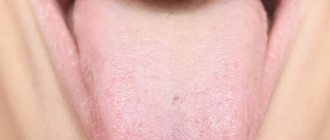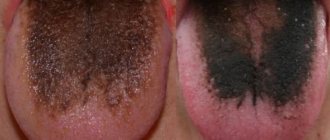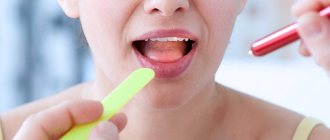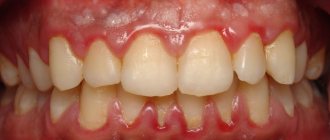When to panic and run to the doctor if you find a green coating
In the morning, almost all people develop a small white-yellow coating on the tongue, which disappears after hygienic cleaning of the oral cavity. If this does not happen and the plaque is difficult to remove, dense, and of an uncharacteristic color, you should consult a doctor. This symptom can appear in an adult, a child, and even an infant. The tongue can have absolutely any color - from white to black, and sometimes even green. Such plaque on the tongue in adults and children most often occurs due to fungal infections, as well as as a consequence of natural aging of the body, HIV infection, diabetes mellitus or cancer. Read more about what this symptom means, why it occurs and how to treat it in today’s material.
Cleaning your tongue with a tongue scraper
Cleaning the surface of the tongue should be an essential part of daily oral hygiene, as the tongue is an ideal place for bacteria to grow. For this purpose, many companies specializing in the manufacture of products for the oral cavity offer special devices that are a combination of a brush and a tongue scraper. The brush has a round, elongated shape with soft bristles.
The brush field itself also has a round shape. The length of the brush ensures that all areas are easily and thoroughly cleaned. The flat shape greatly facilitates manipulation in the oral cavity and prevents the gag reflex. Used to remove plaque from the tongue, thereby preventing the occurrence of caries and bad breath. Provides healthy gums, a feeling of freshness and comfort, improves taste.
What does pathological plaque on the tongue look like?
Before deciding what a coated tongue means and what it is talking about, that is, before making a final diagnosis, the specialist needs to carefully examine the patient’s oral cavity, and also take into account all the accompanying symptoms and complaints. A slight yellowish coating is not a reason to worry. Its formation may be associated with natural physiological processes occurring in the body. If the surface of the tongue has acquired a greenish tint, you should consult a doctor. Perhaps it is a matter of some hidden pathology. Thus, plaque may differ in the following characteristics:
- color, its intensity (we repeat that the norm is a white or slightly yellowish, easily detachable coating),
- consistency (oily, dry, curdled),
- thickness,
- localization.
Why might there be a green coating on the tongue?
What can this mean if a patient has a greenish film on his tongue and a fever? Most often, such symptoms indicate the development of an infectious process in the body. In any case, it is better to immediately consult a doctor so that he can detect the problem at an early stage and offer timely treatment.
Tongue scraper
One of the most necessary accessories for oral care is scrapers for regular tongue cleansing.
A special scraper perfectly cleans the tongue, removes all plaque without scratching the surface of the tongue. Recommended for use with mouth rinse.
Benefits of a tongue scraper:
- Helps freshen breath;
- Improves the sensitivity of taste buds;
- Eliminates bacteria;
- Makes it difficult for infection to enter the body;
- Prevents disease of teeth and gums.
Why does the symptom occur?
So, now let’s figure out why a suspicious green coating forms on the surface of the tongue of a child or adult. The cause of this symptom is most often associated with certain disturbances in the functioning of individual organs or internal systems:
- decreased immunity and, as a consequence, the body’s vulnerability to attack by pathogenic bacteria, or more precisely, fungi,
- improper functioning of the gastrointestinal tract, increased stomach acidity,
- irritating toothpastes and rinses,
- food products containing dyes,
- smoking,
- tongue injuries, including piercings,
- pregnancy,
- taking certain medications: hormone replacement therapy, oral contraceptives, certain antibiotics and corticosteroids.
This is what a fungal infection on the tongue looks like
“This morning I discovered green spots on my one-year-old son’s tongue. We made an appointment with the pediatrician. The doctor examined him. It turned out that antibiotics weakened the baby’s immunity. A month ago we suffered from pneumonia. The pediatrician told me to treat my mouth with a special solution.”
Yulia Egorova, 28 years old. Tobolsk
Diagnostics
To determine a treatment regimen, it is necessary to accurately determine the cause that provoked the formation of green plaque on the surface of the tongue. To do this, you need to make an appointment with a dentist or therapist.
The diagnostic process includes the following steps:
- Based on the information received, the doctor makes a preliminary diagnosis and refers the patient to a specialist
visual examination of the oral cavity by a doctor, collecting information about the patient’s well-being, what complaints he has (the procedure is carried out in bright light with the study of all surfaces of the tongue);
- analysis of the condition of the tongue, taking into account its shape, color, degree of mobility, humidity (topography and papillae are taken into account);
- the procedure for collecting scrapings of green deposits for the purpose of conducting laboratory research (plaque density, odor, and other criteria are considered).
Additionally, a blood test may be required.
Based on the information received, the doctor makes a preliminary diagnosis and refers the patient to a specialist (dentist, gastroenterologist, mycologist, endocrinologist) to confirm the assumptions and prescribe a course of treatment.
Types and associated manifestations
As part of the diagnosis, the specialist must take into account the main characteristics - first of all, the color and intensity of manifestations. Conventionally, several varieties of green plaque can be distinguished, depending on the shade, location and accompanying symptoms. Let's look at these types in more detail.
White with light green spots
A small thickness of plaque is normal. This color may appear during hot weather due to loss of moisture and dehydration. If the tongue is covered with a dense white film, the patient most likely has hyperthermia (high temperature), which indicates an inflammatory process. A sore throat combined with a symptom can trigger an upper respiratory tract infection.
Streptococcal and staphylococcal infections give rise to a white-green coating on the tongue and the presence of viscous, purulent contents on the surface of the tonsils and in the maxillary sinuses. Oral candidiasis is caused by yeast fungi of the genus Candida and also leads to the formation of a white-green plaque1.
White coating with light green spots
Yellow-green or gray-green
This symptom may be a consequence of a recent inflammatory disease of the ENT organs. Yellow-green or gray-green plaque appears in the following cases:
- pathologies of the liver and gall bladder (hepatitis, cholecystitis),
- diseases of the stomach and intestines (gastritis, gastric ulcer, duodenal ulcer, colitis),
- pathology of the duodenum (pancreatitis),
- diseases of the adrenal glands and kidneys,
- pulmonary pathologies.
Yellow-green coating on the tongue
If the color of the surface of the tongue changes and a light green coating appears, it is better to see a doctor immediately. Timely diagnosis will allow you to identify pathology at an early stage, and therefore quickly cure it.
Dark green coating
This is one of the signs of severe functional disorders of the digestive system (GIT). If nausea, vomiting, diarrhea, or general intoxication occurs, urgent assistance from an infectious disease specialist is required.
If the dark green coating is accompanied by a burning sensation, as well as growth and enlargement of the taste buds, a so-called “hairy” tongue can be diagnosed, which most often becomes a consequence of poor hygiene, dehydration, radiation therapy, long-term use of antibiotics, and too frequent consumption of coffee , tea and smoking.
Dark green coating on the tongue
Green-brown and black-green
Green-brown plaque indicates dangerous and severe pathologies of the hematopoietic system. With complicated infectious lesions of the intestines, in particular with cholera, dehydration occurs catastrophically quickly: the blood thickens, the intensity of saliva production decreases, and the black-green coating on the tongue thickens. In the absence of the necessary treatment, everything can end in death.
Green-brown coating on the tongue
Symptoms
In addition to the unsightly appearance of the tongue, the disease may be accompanied by other symptoms. Their presence depends on the cause of the disease.
- Unpleasant odor from the mouth;
- Pain when eating food and drinks;
- Metallic taste in the mouth;
- Nausea, vomiting;
- A sore throat;
- Inflammation of the tongue.
Such symptoms help determine the cause of the disease.
How is diagnosis carried out: we establish the exact cause of the pathology
Self-diagnosis is ineffective - only a specialist can make the correct diagnosis. The therapist or dentist will conduct a visual examination and pay attention to the shade, density and volume of pathological deposits. For in-depth diagnostics, the doctor will prescribe tests and refer you to specialized specialists. You may need to take a clinical blood and urine test, an immunogram, an HIV test, as well as kidney tests to detect kidney inflammation and adrenal dysfunction.
After examination, the otolaryngologist prescribes bacterial culture of the oral mucosa for microflora and sensitivity to antibiotics. If inflammation is confirmed, the specialist will prescribe a course of antibiotic therapy for at least 7-10 days. An x-ray diagnosis of the paranasal sinuses may also be required to rule out sinusitis and sinusitis.
The gastroenterologist prescribes a biochemical blood test, fibrogastroscopy (FGS) with sampling of gastric juice, duodenal intubation and bile sampling, sigmoidoscopy to exclude ulcerative colitis. The results of these tests will help to exclude the presence of gastritis, gastric and duodenal ulcers, and diagnose hepatitis and bile duct dyskinesia. An abdominal ultrasound may also be prescribed. In severe cases, it is necessary to diagnose vascular pathologies, infectious diseases with similar symptoms and exclude cancerous tumors.
Palette
Based on the shade of plaque, you can clarify the situation regarding health problems:
| Analysis of health status by the shade of plaque on the tongue | |
| Name | What disease does the shade indicate? |
| Yellow-green | This symptom indicates the following problems: diseases of the biliary tract, congestion in the gallbladder, excess bilirubin in the body. Yellowness may appear against the background of ARVI, after taking certain medications. |
| White-green | Such plaque does not cause concern if it is easily cleaned off and disappears spontaneously. If there is an intensive build-up of green deposits, you should sound the alarm, because the symptom may indicate an infectious disease. Localization of plaque at the root indicates problems with the gastrointestinal tract (enterocolitis, stomach ulcer, gastritis, duodenal ulcer). |
| Dark green | A dark green or black-green tint is rarely observed and indicates a serious pathology in the body: pancreatic dysfunction, disorders in the bile ducts or gall bladder, dehydration, Crohn's disease, cholera, etc. |
| Gray-green | The color of the plaque indicates problems with the digestive system. After conducting research, the gastroenterologist will determine for sure whether the problem is in the intestines, stomach, or an ulcerative lesion. |
| Brown-green | A brownish color on a green coating indicates fungal or bacterial flora, hepatitis, and acute intestinal poisoning. The shade is also considered characteristic of people who abuse alcohol, as well as heavy smokers. |
Green coating on the tongue - how to treat it
The treatment process can be short-term in the presence of easily correctable conditions. It will take more time to identify the pathology. Treatment methods in this case include the following:
- regular and high-quality oral hygiene (brush your teeth and tongue, rinse your mouth after every meal),
- rinsing with “Chlorhexidine”, “Chlorophyllipt”, “Furacilin”, “Miramistin”. The drugs are used according to the instructions,
- using a special scraper to clean the tongue,
- normalization of diet and drinking regime - you need to reduce the amount of salt consumed, give up fatty and spicy foods.
Chlorhexidine is often prescribed for the treatment of pathology.
As we have already found out, the phenomenon under consideration is not an independent pathology, but a symptom of disturbances in the functioning of internal organs and systems. Therefore, in order to get rid of the greenish coating once and for all, you need to eliminate the root of the problem.
If you have a fungal infection
As we have already noted, it is a fungal infection that is the main reason for the appearance of green deposits on the tongue. As a rule, it is localized in the oral cavity. Therefore, in such a situation, antibiotics will definitely be prescribed - but, preferably, after passing the appropriate tests. However, you shouldn’t hesitate either - the situation can be dangerous.
The specialist will also prescribe general strengthening and immunostimulating drugs, multivitamin complexes and sorbents, as well as agents that normalize intestinal microflora.
For other pathologies
Here, of course, you need to contact a specialized specialist to prescribe specific treatment - these are various drugs to normalize the functioning of the gastrointestinal tract, compliance with the drinking regime and diet.
Danger
There is no need to worry when your tongue turns yellow in the following cases:
- Parents should be alerted to plaque that does not go away for a long time
when staining the mucous membranes and tissues in the oral cavity after consuming products with a coloring effect;
- if oral hygiene is not maintained;
- overeating food, in particular saturated fat;
- after taking medications.
This yellowness disappears after several procedures of cleaning the teeth and the mucous membrane with a special brush.
Parents should be alerted to plaque that does not go away for a long time, especially if other symptoms characteristic of the disease also appear.
This may be increased body temperature, nausea, gag reflex, frequent attacks of heartburn, decreased appetite, and abdominal pain. In this case, it is worth paying attention to the structure of the layer and its shade.
A thick, dense coating with a large localization zone and a green or dark brown tint does not bode well.
When examining the tongue, you can pay attention to the localization of the plaque.
Each place signals disturbances in the functioning of certain organs:
- if yellowness is concentrated on the back of the tongue, there is reason to suspect problems with the intestines;
- a yellow tip indicates a heart problem;
- an uneven plaque with cracks forms on the midline due to gastritis and ulcers;
- the extreme posterior points on the tongue indicate kidney dysfunction;
- coating of the front part and along the edges indicates diseases of the respiratory system;
- when diagnosing the spleen, yellowness is noted on the right, and liver problems are read on the left side;
- plaque over the entire surface with uneven coverage is a signal of decreased immunity.
Is it possible to use traditional medicine?
To eliminate the symptom (namely, the manifestations, but not the treatment of the underlying disease!) You can use vegetable oil. A small amount should be kept in the mouth for 15 minutes. Then spit it out and clean the surface of the tongue using a brush or a special scraper.
Gargling with medicinal herbs will help in treatment
It is also recommended to rinse your mouth with a decoction of herbs: mint, calendula, St. John's wort. To do this you need to take 15 grams. each of the herbs, brew the mixture in 250 ml of boiling water and let the product brew. You can wipe the surface of the tongue with a soda solution: 2 tbsp. You need to dilute it in 150 ml of water, then moisten a cotton pad or gauze pad in the resulting solution and cleanse it. The procedure should be repeated twice a day.
It is important to immediately note that traditional medicine can only act as a supportive therapy, but not the main one! Do not try to self-medicate, because you can not only aggravate the situation, but also trigger the pathology, bring it to the stage of development when complex and lengthy treatment, possibly even surgery, is required. You can use “grandmother’s” recipes only after agreement with your doctor.
Prevention measures
To minimize any risk of an unpleasant symptom, competent and systematic prevention of diseases of the oral cavity and digestive system should be ensured. In this regard, experts suggest being guided by the following principles:
- double daily brushing of teeth and oral cavity,
- rejection of bad habits,
- normalization of diet and drinking regime,
- use of multivitamin preparations,
- undergoing preventive examinations for early diagnosis of pathologies,
- timely treatment of chronic diseases.
The tongue serves as a kind of indicator of the state of the whole organism. If spots, dense plaque of an unhealthy color, or suspicious growths appear on its surface, you should immediately run to the doctor. The sooner you seek help from a professional, the easier and faster the problem can be resolved.
- Banchenko G.V. Language is the “mirror” of the body: a clinical guide for doctors, 2000.
Treatment
The main principle of treating green plaque is to eliminate the cause. It is useless to fight the symptomatic manifestation, the effect will not last long, and the underlying disease can cause complications in the wasted time.
If no pathologies are detected after the diagnosis, the specialist gives recommendations regarding diet and oral hygiene procedures.
The consequences of bad habits are also discussed. Even if the patient does not neglect daily brushing of teeth, this does not mean that such procedures are sufficient.
After each meal, you should rinse your mouth with a special solution (if there are no problems with an unpleasant odor, then you can get by with clean water).
After eating fibrous foods, you should floss. You also need to pay attention to the technique of brushing your teeth and oral mucosa.
When identifying a disease that provoked a layer on the tongue, the treatment regimen is selected depending on the etiology and stage of development:
- If the functioning of the gallbladder is impaired, the following are prescribed: Allohol, Tanacechol, Liobil, Vigeratin, that is, drugs that have a choleretic effect.
- Complex therapy involves the use of several agents, including an antispasmodic (Atropine, Duspatalin).
- No-spa has a broad effect, but its use is excluded for prostate hypertrophy.
- For peptic ulcers (stomach and duodenum), Drotaverine is prescribed. However, use is contraindicated if the patient is diagnosed with renal or liver failure.
- If the cause of the green plaque is a diseased liver, then it is recommended to treat it with the drug Legalon, developed on the basis of herbal components.
- Cholenzym is used to eliminate problems with the digestive system.
- The treatment regimen for infectious diseases involves the use of antibiotics. Among the most popular drugs is Ampicillin. The product is appropriate to use for problems with the upper respiratory tract, gastrointestinal tract, scarlet fever, and skin lesions.
- When carrying out therapy aimed at eliminating liver dysfunction, the following are used: Legalon, Karsil, Essentiale. The drugs effectively stimulate the regenerative function of the body and promote the rapid restoration of damaged liver cells.
- Among the popular antiviral agents that effectively eliminate the cause that provoked the formation of green plaque: Reaferon, Adapromin, Arbidol.
- To treat a fungal infection, it is necessary to supplement therapy with antifungal drugs (Griseofulvin, Mikosist, Fluconazole).
- If the patient exhibits signs of intoxication, the doctor prescribes Enterosgel, Activated Carbon, Polysorb.
Traditional treatment can be supplemented with traditional medicine recipes, but completely replacing therapy with them is strictly contraindicated.











